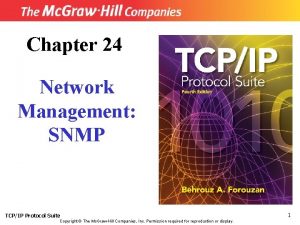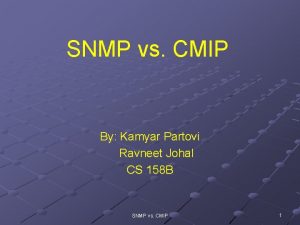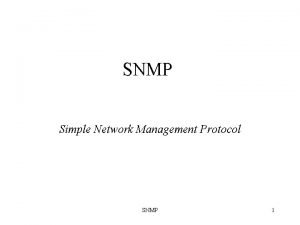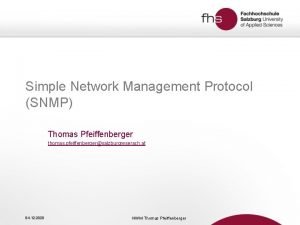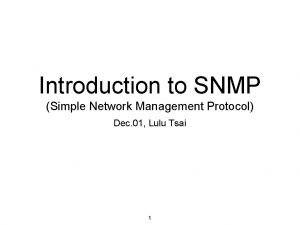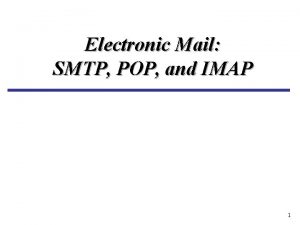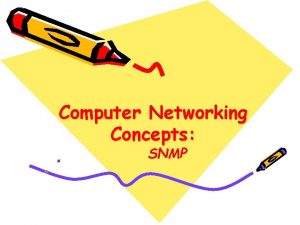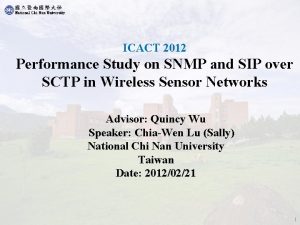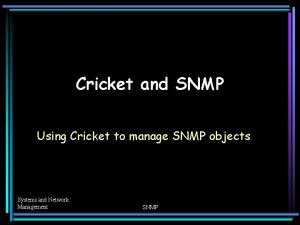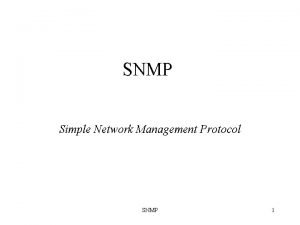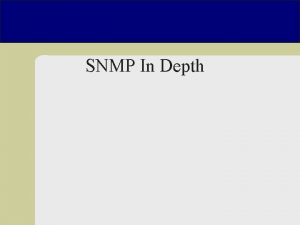ICACT 2012 Performance Study on SNMP and SIP













- Slides: 13

ICACT 2012 Performance Study on SNMP and SIP over SCTP in Wireless Sensor Networks Advisor: Quincy Wu Speaker: Chia-Wen Lu (Sally) National Chi Nan University Taiwan Date: 2012/02/21 1

Wireless Sensor Network (WSN) • IEEE 802. 15. 4 is a wireless communication standard protocol – Wireless personal area network – Characteristics: low data rate, low power consumption, short distance transmission • Myriads of applications – Smart grids, home automation and so on 3

Zig. Bee/6 Lo. WPAN IPv 6 over Low power Wireless Personal Area Network (6 Lo. WPAN) 6 Lo. WPAN Zig. Bee APS (Application Layer) Application Layer Zig. Bee NWK (Network Layer) Network Layer (IPv 6) Transport Layer Lo. WPAN IEEE 802. 15. 4 Date Link/Physical Layer IEEE 802. 15. 4 Data Link/Physical Layer Protocol Stack 4

Zig. Bee/6 Lo. WPAN WSN Management • No universal network management protocol standard to jointly manage heterogeneous Zig. Bee and 6 Lo. WPAN devices. • Application layer protocol – Session Initiation Protocol (SIP) – Simple Network Management Protocol(SNMP) 7

SIP and SNMP • SIP – A signaling control protocol in Voice over Internet Protocol (Vo. IP) – Extensions: register, subscribe, notify, instant messaging (IM), presence, and so on • SNMP – Monitor and configure network devices • Application protocol – SIP/SNMP usually run over UDP/TCP 8

Stream Control Transmission Protocol (SCTP) • SCTP is new reliable and message-oriented transport layer protocol • Two powerful functions make SCTP a highly efficient and reliable transmission mechanism – Multi-homing – Multi-streaming 9

SCTP (Cont. ) • Multi-homing – Multiple network connection paths – Redundancy mechanism data P 1 master P 1 Internet P 2 sender data backup P 2 receiver 10

SCTP(Cont. ) • Muli-streaming – Classify data into different categories to be transferred by independent streams – Congestion control mechanism only slow down which stream occurs packets lost Receiver Sender Application association SCTP IP data 1 Stream 0 data 2 Stream 1 SCTP IP 11

SIP/SNMP over SCTP • Zig. Bee/6 Lo. WPAN WSN – Lossy communication channels – Low data rate – Small packet sizes • Example: Zig. Bee WSN – 2. 4 GHz radio band – Data rate of 250 kbps • SIP over SCTP or SNMP over SCTP may be a good idea to increase the management performance in WSNs 12

System Architecture Zig. Bee Network 13

System Architecture 6 Lo. WPAN Network 14

Conclusion and future work • Some interesting future work would be analyzing the behavior of SIP and SNMP over SCTP in WSNs by simulation tools, and verified its performance in real testbeds. • This would allow network administrators to wisely choose the best management protocol to manage their WSNs. 17

Thanks for your attention. 18 NCNU: http: //www. ncnu. edu. tw/ncnuweb/
